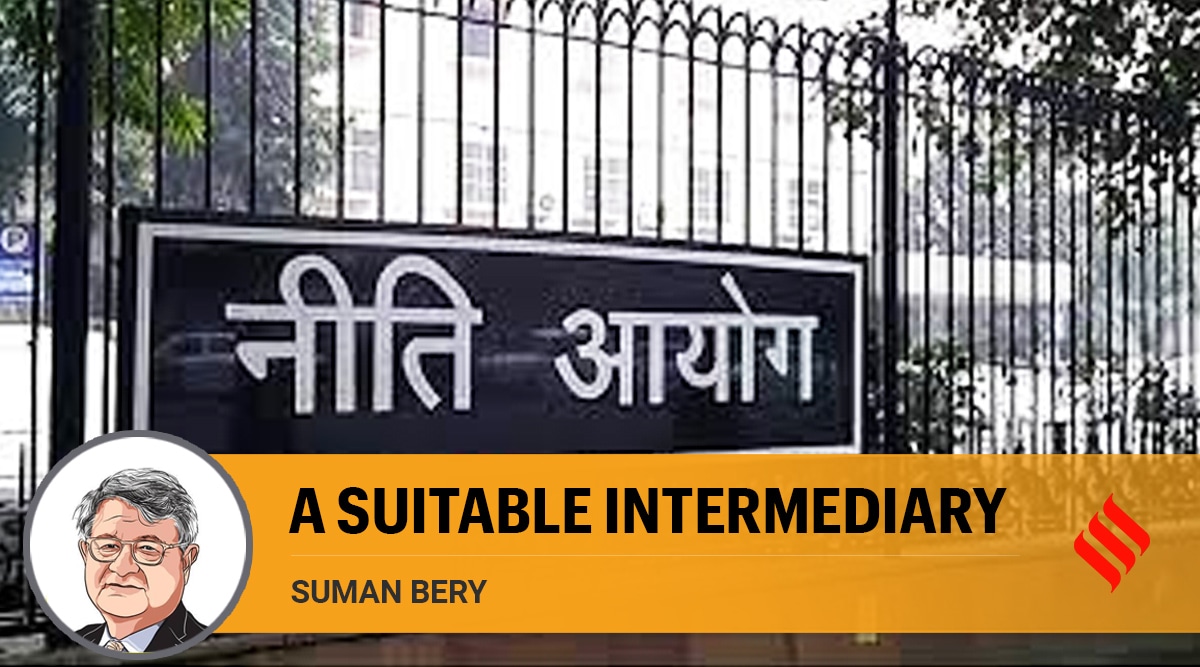 Since its inception in 2015, NITI Aayog has been instrumental in promoting competitive and cooperative federalism. (File Photo)
Since its inception in 2015, NITI Aayog has been instrumental in promoting competitive and cooperative federalism. (File Photo)How should the NITI Aayog work to improve alignment between the Centre and states as part of ‘Team India’? This would have several dimensions — establishing open borders within the country for an open labour market; facilitating effective implementation of national programmes that promote job creation, improve the quality of the labour force and enhance ease of doing business; ensuring high-quality public expenditure, particularly capital expenditure; and ensuring policy predictability at the state level.
Since its inception in 2015, NITI Aayog has been instrumental in promoting competitive and cooperative federalism. NITI Aayog organises the annual meeting of the Governing Council (GC) under the leadership of the PM, which brings together chief ministers/Lieutenant-governors of the states/UTs to discuss inter-sectoral, inter-departmental and federal issues to accelerate the implementation of the National Development Agenda. As a run-up to the 2022 GC meeting, the first National Conference of Chief Secretaries was held in Dharamshala from June 15-17. This was also the first time that I, as vice-chairman, NITI Aayog, met all the chief secretaries and other senior officials of all states/UTs on a single platform. The time spent at Dharamshala enriched my understanding of NITI Aayog’s role in enhancing alignment between the Centre and states and helped crystallise my thoughts in the form of seven propositions.
Proposition one: India’s growth is that of its states and UTs. As custodians of regional policy and prime executors of development programmes, states are the Indian economy’s growth drivers. States control urban governance, agriculture, power distribution, land records modernisation, labour law simplification and pollution control. For India to remain one of the fastest-growing major economies, states must identify their strengths. NITI Aayog must ensure productive engagement and dialogue with the states to develop a growth roadmap.
Proposition two: To achieve greater socio-economic cohesion within the country, achieving income convergence across states must be a policy priority. Despite country-wide economic growth, the less developed Indian states are not catching up. Over the last two decades, half of India’s GDP has been contributed by just a handful of states. Broadly, states that have been able to get on the growth ladder have been able to stay there, while the lagging states have found it challenging to catch up. NITI Aayog needs to engender discourse to address this crucial issue through improved governance structures, adequate financial development and infrastructure.
Subscriber Only Stories
Proposition three: In addition to income growth, performance on social indicators is a sound metric for assessing a state’s performance. Social outcomes are de-linked from income in several states. Mizoram’s performance on the Infant Mortality Rate (IMR) is one example. Despite being a middle-income state, its IMR is the lowest at 3 deaths per 1,000 live births, whereas the national average is 28. NITI Aayog has developed several social sector indices and dashboards for effectively tracking and monitoring outcomes. Regular monitoring and performance evaluation will incentivise states to achieve better social outcomes.
Proposition four: We must focus on ensuring that growth originates from the grassroots while addressing significant inter-state and inter-district variations. The Prime Minister launched the Aspirational Districts Programme (ADP) to address these challenges through data-driven, outcome-based governance. The programme focuses on fostering competition among districts, enabling convergence of schemes and promoting collaboration. While lauding the ADP during the conference, the PM emphasised the need to convert the Aspirational Districts into “inspirational districts”. NITI Aayog must focus on guiding state governments in replicating the ADP template at the block level and for districts not categorised as aspirational.
Proposition five: Better managed urbanisation is crucial. Cities face challenges such as affordable housing, water supply and waste management. Further, there is a need to tap into resources other than government budgets, such as monetising land assets and engaging private capital in service delivery. Efforts to empower and make large urban local bodies atmanirbhar are the needs of the hour.
Proposition six: Several best practices are already being implemented by states across India. NITI Aayog must act as an intermediary between the Centre and states to ensure cross-sharing of these best practices, insights and perspectives. Some areas that merit particular focus are the use of advanced technology using blockchain and AI, development of social registry, reducing compliance burden, implementation of PM Gati Shakti, decriminalisation of minor offences and simplification of laws and processes to enhance ease of doing business.
Proposition seven: The challenge of climate change is upon us. The world has so far witnessed two models of development— the Industrial Revolution and the rise of East Asia. Both depended on cheap, fossil-fuel energy. India aspires to grow equally fast but is now subject to a carbon constraint. At the state level, it is crucial to frame the decarbonisation challenge in the context of the states’ urgent need to create millions of new jobs, increase incomes and improve public health. It is critical to understand how the challenges facing states might be affected by decarbonisation, both with regard to mitigation and adaptation. We need to continue our national debate around this challenge. Using its convening power, NITI Aayog is well-positioned to generate such a conversation and guide states to catalyse climate action.
The writer is vice-chairman, NITI Aayog. Views expressed are personal. He would like to thank Tanushree Chandra and Manpreet Kaur for their research assistance
- The Indian Express website has been rated GREEN for its credibility and trustworthiness by Newsguard, a global service that rates news sources for their journalistic standards.

